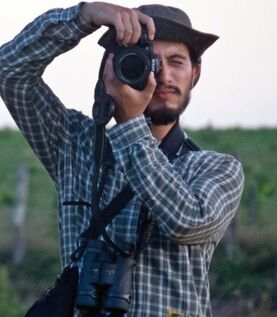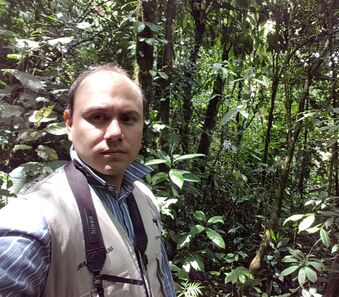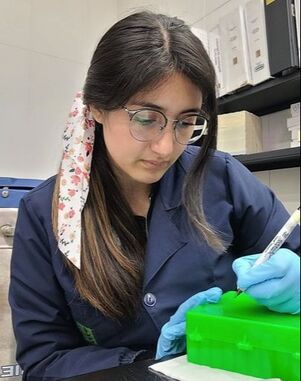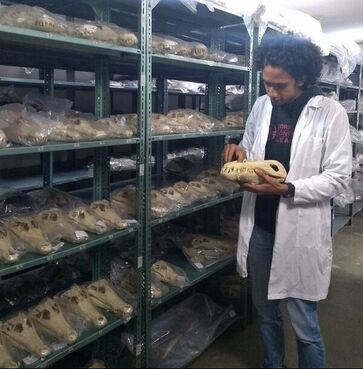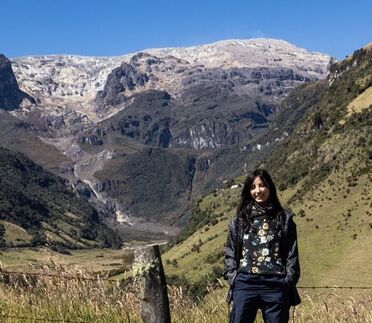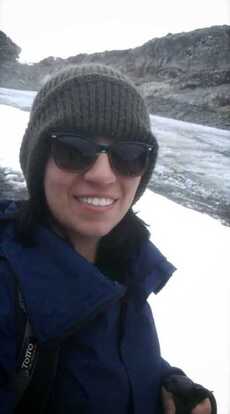Ph.D. Students
|
Juan Camilo Ríos-Orjuela
Ph.D. Student j.rioso[at]uniandes.edu.co |
My research interests encompass mainly evolutionary ecology and functional morphology. I am especially intrigued by the evolution of phenotypic traits and how phenotypic evolution allows species to occupy geographical niches. I’m currently focusing on evaluating how the nectarivorous diet has shaped morphology, diversification, and niche occupation of hummingbirds at continental spatial scales. To do this, I use different methodological frameworks such as morphometrics, ecological traits, distribution models and phylogenetic comparative methods. I’m also interested in citizen science and scientific communication as tools for conservation and social appropriation of knowledge. Google Scholar Profile | Personal Website |
|
Miguel Moreno-Palacios
Ph.D. Candidate mc.morenop[at]uniandes.edu.co |
I am focused in studying the life cycles of Neotropical birds, and how they are affected by ecological and evolutionary pressures. I describe general life cycles of birds (initially passerine birds), including molt and breeding cycles, and I relate them to climatic and habitat variables. With a morphological, bioacoustic, and molecular approach I want to elucidate how geographic shifts in the phenology of life cycles caused by climatic asynchrony may promote population genetic structure and speciation. I also enjoy doing community ecology stuff, involving analyses of alpha and beta diversity using data from different organisms in bioindicator studies.
Google Scholar Profile | Personal Website |
Masters Students
|
Jessica Burbano
Masters Student j.burbanoh[at]uniandes.edu.co Nelson Falcón
Masters Student n.falcon[at]uniandes.edu.co Paula Navarro
Masters Student p.navarros[at]uniandes.edu.co |
I have experience in the study of the evolutionary history and systematics of birds in the Colombian Caribbean. Since 2019, I have participated in various biological expeditions to monitor the country's avian biodiversity, where I have supported explorations and monitoring in Valle del Cauca, Nariño, San Andrés and Providencia. My research interests are in deciphering evolutionary enigmas of different groups of birds, biological collections, participatory science, and the dissemination of knowledge. My research goals are mainly focused on ecology, functional morphology, and their relationship to evolution, mainly in amphibians, reptiles and fishes. I am especially intrigued by the evolution of phenotypic traits and how phenotypic evolution allows species to occupy their geographical niches. To do this, I employ tools including linear and geometric morphometrics, ecological traits, distribution models and phylogenetic comparative methods. I am also interested in citizen science and scientific communication as tools for effective conservation and social appropriation of knowledge My research goals are mainly focused on ecology, functional morphology, and their relationship to evolution, mainly in amphibians, reptiles and fishes. I am especially intrigued by the evolution of phenotypic traits and how phenotypic evolution allows species to occupy their geographical niches. To do this, I employ tools including linear and geometric morphometrics, ecological traits, distribution models and phylogenetic comparative methods. I am also interested in citizen science and scientific communication as tools for effective conservation and social appropriation of knowledge. |
|
Katherine Sánchez
Masters Student k.sanchezg2[at]uniandes.edu.co |
My research goals are mainly focused on ecology, bioacoustics, and animal behavior in vertebrates. I have a great interest in elucidating how anthropogenic intervention may lead to changes in behavioral patterns of species, and in this way contributing to knowledge, both in these areas and the protection of wildlife. |
Undergraduate Students
Juliana Novoa. Exploring the link between morphological beak traits and lice Infestation in hummingbirds (Trochilidae). Main advisor: Juliana Soto-Patiño.
Lab Alumni
Former Postdocs
Dr. Andrés M. Cuervo Google Scholar Profile | Personal Website
Dr. Andrés Quiñones Google Scholar Profile | Personal Website
Dr. Glenn Seeholzer Google Scholar Profile | Personal Website
Former Ph.D. Students
Jorge E. Avendaño. Ph.D. Biology, 2021. Plumage evolution in Neotropical finches: An evolutionary and behavioral approach. Google Scholar Profile
Mileidy Betancourth-Cundar. Ph.D. Biology, 2022. Unraveling territorial behavior in Neotropical poison frogs: an integrative natural history approach. Google Scholar Profile
Camila Gómez. Ph.D. Biology, 2018. Ecological and evolutionary processes that shape the long-distance migrations of birds. Coadvised with Dr. Keith A. Hobson. Google Scholar Profile | Personal Website
Oscar A. Laverde. Ph.D. Biology, 2016. Visual and acoustic communication signals in birds: taxonomy, evolution and transfer between signals mediated by sensory drive. Personal Website
Catalina Palacios. Ph.D. Biology, 2020. Evolution, speciation, and genomics of the Andean hummingbirds Coeligena bonapartei and Coeligena helianthea. Google Scholar Profile
Paulo C. Pulgarín, Ph.D. Biology, 2018. Bird-parasite interactions in tropical forests: an ecological and evolutionary perspective. Google Scholar Profile | Personal Website
Former Masters Students
Jorge E. Avendaño. M.Sc. Biology, 2010. Molecular phylogenetics, phylogeography, geographic variation, and species limits in the Chlorospingus ophthalmicus complex (Aves, Emberizidae). Publication 1 | Publication 2
Ghislaine Cárdenas. M.Sc. Biology, 2013. Female mate choice in a lek mating system: Assessing behavioral correlates of mating success. Coadvised by Dr. Bette Loiselle, University of Florida. Publication
Lina María Caro. M.Sc. Biology, 2010. Ecological speciation in an elevational gradient in a tropical passerine bird: a morphological, genetic, and behavioral approach. Publication 1 | Publication 2 | Publication 3
Laura Natalia Céspedes. M. Sc. Biology, 2018. Extensive hybridization between two Andean warbler species with little divergence in mtDNA. Coadvised with Andrés M. Cuervo.
Perla Catalina Chaparro. M.Sc. Biology, 2013. A theoretical approach to understanding mate-searching behavior in females. Coadvised by Dr. Juan M. Cordovez, Universidad del los Andes.
Mateo Dávila, M.Sc. Biology, 2020. How do opposing pressures of sexual and natural selection in continental and insular settings shape the evolution of coloration in a tropical gecko? Coadvised by Dr. Diego Cisneros, Universidad San Francisco de Quito.
Andrés Felipe Diaz, M. Sc. Biology, 2023. Phylogeography of a sex-limited polymorphism: Disentangling phenotypic variation in the Tourmaline Sunangel, Heliangelus exortis.
Alexander Florez. M.Sc. Biology, 2012. Four pulses of diversification and differential migration rates across the Andes explain the structuring of genetic diversity in an assemblage of Neotropical lowland birds.
Silvana García. M.Sc. Biology, 2010. Testing the divergence-with-gene-flow model of ecological speciation in two species of Andean hummingbirds.
Valentina Gómez. M.Sc. Biology, 2014. A behavioral polymorphism as an intermediate stage in the evolution of divergent forms: partial migration in New World flycatchers (Aves, Tyrannidae).
Juan Pablo Gómez. M.Sc. Biology, 2009. A phylogenetic approach to disentangling the role of competition and habitat filtering in community assembly in Neotropical forest birds. Publication
Natalia Gutiérrez. M.Sc. Biology, 2013. Testing adaptive hypotheses at a continental level: phylogeography, hemoglobins and morphology of Torrent Ducks in replicate elevational gradients across latitudes. Coadvised by Dr. Kevin McCracken, University of Alaska. Publication
María Lozano. M.Sc. Biology, 2013. Combining phylogeography and the geography of adaptation to understand population history: Ruddy Ducks in the New World. Coadvised by Dr. Kevin McCracken, University of Alaska. Publication 1 | Publication 2
María Alejandra Meneses. M.Sc. Biology, 2022. Exploring the potential implications of variation in optical density for the coevolution of avian visual systems and color signals. Coadvised by Dr. Natasha Bloch.
Paola Montoya. M.Sc. Biology, 2018. Why did some animals participate in the Great American Biotic Interchange and others did not? The influence of dispersal ability and niche breadth. Coadvised by Dr. Andrew Crawford.
Andrea Morales. M.Sc. Biology, 2010. Origin and dynamics of a hybrid zone between Ramphocelus tanagers (Thraupidae) in Colombia. Publication
Ángela P. Navas. M.Sc. Biology, 2010. Testing the influence of isolation and adaptive evolution on genetic and phenotypic differentiation in a Neotropical montane bird.
David Ocampo, M.Sc. Biology, 2015. Evolution of avian eggshell function and structure: evidence for adaptation across elevational gradients? Coadvised by Dr. Gustavo Londoño, Universidad ICESI.
Carlos A. Pedraza. M.Sc. Biology, 2011. The influence of Quaternary climate fluctuations on spatial distribution patterns of lowland avian species in northern South America. Publication
Simón Quintero. M.Sc. Biology, 2014. Disentangling the direct and indirect effects of latitude on geographic range size among New World heliothermic lizards.
Jorge L. Romero. M. Sc. Biology, 2019. Bacterial evolution under optimal conditions: A new method for the development of long term evolutionary experiments with E. coli. Coadivised by Dr. Juan Manuel Pedraza.
Camilo Sanín. M.Sc. Biology, 2010. Contribution of differential diversification rates to current broad-scale patterns of species richness in South American birds. Coadvised by Dr. Iván Jiménez, Missouri Botanical Garden.
Elkin A. Tenorio. M.Sc. Biology, 2013. Effect of dispersal abilities and climatic niche breadth on avian diversification rates.
Eugenio Valderrama. M.Sc. Biology, 2010. Phylogeography and historical landscape genetics of a Neotropical montane forest bird: the influence of the complex topography and dynamic history of the Andes on evolutionary differentiation. Publication
Former Undergraduates (main advisor)
Jorge Mario Cárdenas. B.Sc. Biology, 2008. Identificación y caracterización de las isoenzimas de la LDH (Lactato Deshidrogenasa) durante el desarrollo tardío en alevinos de Onchorhynchus mykiss en variedades importadas.
Laura Natalia Céspedes. B.Sc. Biology, 2014. Colorful tropical birds are more colorful at higher elevations: A role for predation? Coadvised by Oscar Laverde.
Juan Camilo Chaves. B.Sc. Biology, 2008. Species limits in the Myrmeciza laemosticta complex (Aves: Passeriformes: Thamnophilidae). Publication
Andrés Del Risco. B.Sc. Biology, 2010. ¿Evolución de aves diurnas a partir de ancestros nocturnos? Implicaciones de un reanálisis de la filogenia de los Caprimulgiformes y Apodiformes.
Alexander Florez. B.Sc. Biology, 2009. Reconstructing the phylogeny of “Buarremon” brush-finches and near relatives (Aves, Emberizidae) based on individual gene trees: a multilocus approach. Publication
Javier A. Gómez, B. Sc. Biology, 2017. Ausencia de monofília recíproca y variación geográfica en la estructura poblacional en dos aves andinas con alta diversidad fenotípica (Myioborus ornatus y Myioborus melanocephalus, Parulidae).
Diana Patricia Martinez. B.Sc. Biology, 2008. Distribución histórica de aves de tierras bajas de Colombia modelada con referencia a cambios climáticos: una prueba de la hipótesis de los refugios del Pleistoceno.
Carolina Montealegre. B.Sc. Biology. 2009. Patrones de diversidad en ensamblajes de aves en dos bosques de niebla de la Cordillera Occidental de Colombia.
María Alejandra Meneses. B.Sc. Biology. 2018. Plumage convergence in tyrant flycatchers: A tetrachromatic view
Ángela P. Navas. B.Sc. Biology, 2008. Phylogeography and patterns of genetic and morphological variation in Diglossa albilatera (Aves: Thraupidae): Testing the influence of isolation and adaptive evolution on population differentiation.
Pablo J. Negret. B.Sc. Biology, 2010. Acercamiento ecológico y filogenético a los modos de especiación en el género Tangara (Aves, Thraupidae).
Ignacio Quintero. B.Sc. Biology, 2011. Asynchrony of seasons: population differentiation resulting from geographic variation in avian reproductive phenology? Publication
Juliana Sandoval. B.Sc. Biology, 2016. Is the largest river valley west of the Andes a driver of diversification in Neotropical lowland birds?. Coadvised by Juan Pablo Gómez.
Nubia Suárez. B.Sc. Biology, 2010. Comunidades de aves de alta montaña en el Parque Nacional Natural El Cocuy. Publication
Eugenio Valderrama. B.Sc. Biology, 2008. Filogeografía de Premnoplex brunnescens (Aves, Furnariidae), una especie neotropical de tierras altas.
Korik Vargas. B.Sc. Biology, 2007. Evaluación del estado taxonómico del cucarachero de Nicéforo Thryothorus nicefori (Aves: Troglodytidae) mediante métodos morfológicos y genéticos.
Francisco J. Velásquez. B.Sc. Biology, 2008. Patrones de diversificación y diferenciación genética en Myadestes ralloides (Passeriformes, Turdidae) a lo largo del complejo andino.
Former Undergraduates (coadvisor)
Nohora Viviana Alarcón. B.Sc. Biology, 2012. Evaluación del efecto de factores locales y del paisaje sobre la comunidad de aves en cercas vivas en un paisaje ganadero en la Orinoquía colombiana. Director: Dr. Luis Miguel Renjifo.
Angela María Amaya. B.Sc. Biology, 2009. Efecto del retamo espinoso sobre las aves de borde en un bosque altoandino. Director: Dr. Luis Miguel Renjifo. Publication
Santiago Ávila. BSc. Biology, 2020. Exploring the genetic basis of melanic coloration in Diglossa flowerpiercers (Thraupidae) Director: Jorge E. Avendaño.
Andrea C. Baquero. B.Sc. Biology, 2008. Divergence of adaptive phenotypic traits and mate recognition systems (song and color) in response to recent anthropogenic habitat changes in an oceanic island (Sao Tomé, Gulf of Guinea) endemic passerine (Speirops lugubris). Director: Dr. Martim Pinheiro de Melo.
Diego Beltrán. B.Sc. Biology, 2016. Color reflectance in two iridescent Andean hummingbirds and its nanostructural basis. Director: Dr. Juan Luis Parra.
Santiago Bateman. B.Sc. Biology, 2009. Aspectos de la interacción planta-colibrí del bosque de niebla de la Laguna de Pedro Palo. Director: Aquiles Gutiérrez.
Paula Cardozo. B.Sc. Biology, 2019. Geographic distribution and land transformation in the wintering grounds of the Blackpoll Warbler (Setophaga striata): Is deforestation associated with population decline? Director: Dr. Camila Gómez.
María Isabel Castaño. B.Sc. Biology, 2018. Home-range size of an Andean Bird: Assessing the role of physical condition. Director: Jorge E. Avendaño.
L. Santiago Castillo. B.Sc. Biology, 2008. Importancia del banco de semillas y de la dispersión post-disturbio en la regeneración de plantas en claros naturales de un bosque amazónico colombiano. Director: Dr. Pablo Stevenson. Publication
María Alejandra Chadid. B.Sc. Biology, 2010. Comunidades de aves residentes en cinco humedales con diferentes tipos de manejo en la Sabana de Bogotá, Colombia. Director: Juan Pablo Gómez.
Andrés Felipe Díaz. B.Sc. Biology, 2020. Effects of molt on hovering kinematics of hummingbirds. Director: Dr. Alejandro Rico.
María Camila Esteban. B. Sc. Biology, 2017. Is prevalence of blood parasites in birds related to host ecological traits? An assemblage-wide study in northern Colombia. Director: Paulo Pulgarín.
María Camila Esteban. B. Sc. Microbiology, 2019. Are blood parasite infections associated with the immune and energetic condition of a migratory passerine bird?. Director: Paulo Pulgarín.
Alejandro Fajardo. B.Sc. Biology, 2011. An application of evolutionary game theory: cooperation during intraspecific fights. Director: Dr. Juan Manuel Cordovez, codirector Dr. José Ricardo Arteaga.
Juan Sebastían Flórez, B. Sc. Biology, 2018, Universidad Industrial de Santander. ¿Cuántas veces colonizaron las cuevas las especies de bagres cavernícolas (Trichomycterus spp.) de Santander? Advisor: Dr. Mauricio Torres, coadvisor: Dr. Carlos DoNascimiento.
Lucía Gaitán. B.Sc. Biology, 2010. Avifauna y certificación ambiental - un estudio de caso en Santander (Colombia). Director: Dr. Andrés Guhl.
Laura N. Galindo. B.Sc. Biology, 2009. Efecto de la restauración hidrogeomorfológica sobre la riqueza y abundancia de la avifauna en tres sectores del humedal La Conejera, Bogotá. Director: Efraín Ruiz.
J. Sebastián Gonzalez. B.Sc. Biology, 2015. Effects of elevation, spatial scale and data sources on the phylogenetic structure of hummingbird communities. Directors: Dr. Juan Luis Parra, Dr. Catherine Graham. Publication
Daniel A. Gutiérrez. B.Sc. Biology, 2022. Seasonal variation in the nasty-neighbor effect in a Neotropical songbird. Director: Dr. Jorge Avendaño.
Natalia Gutiérrez. B.Sc. Biology, 2009. Patrones históricos y geográficos de la diversificación de un complejo de aves (Parulidae: Basileuterus) del bosque montano neotropical. Director: Andrés M. Cuervo. Publication
Melissa Hernández. B.Sc. Biology, 2020. Rasgos predictores de la personalidad y posibles consecuencias para el comportamiento migratorio del Zorzal Carigrís (Catharus minimus). Director: Dr. Camila Gómez.
Santiago Herrera. B.Sc. Biology, 2020. Ciencia participativa como una alternativa para estudiar migración altitudinal en aves neotropicales. Director: Dr. Camila Gómez.
Astrid P. Ibáñez. B.Sc. Biology, 2017. Unveiling the migratory strategy of the Gray-Cheeked Thrush (Catharus minimus) through analyses of diet during spring stopover. Director: Camila Gómez.
María Lozano. B.Sc. Biology, 2010. Intraspecific variation and the origin and maintenance of the disjunct distribution of the Blossomcrown Anthocephala floriceps (Aves, Trochilidae). Director: Alejandro Rico. Publication
María Laura Mahecha. B.Sc. Biology, 2020. Diet influences metabolic rates in Neotropical birds. Director: Dr. Camila Gómez, Codirector: Dr. Gustavo Londoño.
Juan Diego Martínez. B.Sc. Biology, 2015. Critical thermal limits of Poecilia caucana (Steindachner, 1880) (Cyprinodontiformes: Poeciliidae). Director: Dr. Mauricio Torres. Publication
Bryan E. Mateus. B.Sc. Biology, 2023. Divergence in beak morphology, foraging behavior and diet among migratory and year-round resident Fork-talied Flycatchers (Tyrannus savana). Director: Dr. Valentina Gómez.
Iliana R. Medina. B.Sc. Biology, 2008. Differential evolution of color pattern elements in the aposematic frog Oophaga histrionica. Director: Dr. Adolfo Amézquita.
María Elisa Mendiwelso. B.Sc. Biology, 2023. The hidden world of egg coloration: exploring the drivers of variation in UV reflectance. Director: David Ocampo.
Elena Montes. B.Sc. Biology, 2008. Evaluación de la efectividad de las cercas vivas como mecanismo de conservación de la avifauna del Neotrópico. Director: Dr. Luis Miguel Renjifo.
Andrés Palomino. B.Sc. Biology, 2007. Biogeografía de los peces de los Andes de Colombia. Director: Dr. Santiago Madriñán.
Néstor A. Peralta. B.Sc. Biology, 2010. Influencia de la temperatura ambiental sobre los comportamientos de incubación en una comunidad de aves Passeriformes: retroalimentación al modelo de Conway & Martin (2000). Director: Gustavo A. Londoño.
Viviana Quiroga. B.Sc. Biology, 2011. Algunos aspectos de la calidad del agua de los humedales de la sabana de Bogotá y su relación con la diversidad de aves acuáticas. Director: Loreta Rosselli.
Juliana Rodríguez. B.Sc. Biology, 2020. Vocal behavior and microgeographical variation in song types in a Neotropical songbird. Director: Jorge E. Avendaño.
Maria Paula Rodríguez. B.Sc. Biology, 2022. An integrative analysis of genetic and phenotypic variation of the Chlorospingus flavopectus complex: How many species exist in South America?Director: Jorge E. Avendaño.
Luis Alfonso Rojas. B.Sc. Biology, 2010. Habitat use and its influence on the phylogenetic structure of Neotropical avian assemblages. Director: Juan Pablo Gómez.
Laura Natalia Romero. B.Sc. Biology, 2009. Efectos de la temperatura en la determinación del sexo de los neonatos y validación del método de sliding landmarks para determinar el sexo con base en morfometría en la tortuga Dermochelys coriacea. Director: Dr. Nicole Valenzuela.
Camilo Sanín. B.Sc. Biology, 2009: Paraphyly of Cinclodes fuscus (Aves: Passeriformes: Furnariidae): Implications for taxonomy and biogeography. Director: Dr. Terry Chesser. Publication
Lina María Valencia. B.Sc. Biology, 2009. Phylogeography of Brown Spider Monkeys (Ateles hybridus): Testing the riverine barrier hypothesis. Director: Dr. Andrés Link. Publication
Dr. Andrés M. Cuervo Google Scholar Profile | Personal Website
Dr. Andrés Quiñones Google Scholar Profile | Personal Website
Dr. Glenn Seeholzer Google Scholar Profile | Personal Website
Former Ph.D. Students
Jorge E. Avendaño. Ph.D. Biology, 2021. Plumage evolution in Neotropical finches: An evolutionary and behavioral approach. Google Scholar Profile
Mileidy Betancourth-Cundar. Ph.D. Biology, 2022. Unraveling territorial behavior in Neotropical poison frogs: an integrative natural history approach. Google Scholar Profile
Camila Gómez. Ph.D. Biology, 2018. Ecological and evolutionary processes that shape the long-distance migrations of birds. Coadvised with Dr. Keith A. Hobson. Google Scholar Profile | Personal Website
Oscar A. Laverde. Ph.D. Biology, 2016. Visual and acoustic communication signals in birds: taxonomy, evolution and transfer between signals mediated by sensory drive. Personal Website
Catalina Palacios. Ph.D. Biology, 2020. Evolution, speciation, and genomics of the Andean hummingbirds Coeligena bonapartei and Coeligena helianthea. Google Scholar Profile
Paulo C. Pulgarín, Ph.D. Biology, 2018. Bird-parasite interactions in tropical forests: an ecological and evolutionary perspective. Google Scholar Profile | Personal Website
Former Masters Students
Jorge E. Avendaño. M.Sc. Biology, 2010. Molecular phylogenetics, phylogeography, geographic variation, and species limits in the Chlorospingus ophthalmicus complex (Aves, Emberizidae). Publication 1 | Publication 2
Ghislaine Cárdenas. M.Sc. Biology, 2013. Female mate choice in a lek mating system: Assessing behavioral correlates of mating success. Coadvised by Dr. Bette Loiselle, University of Florida. Publication
Lina María Caro. M.Sc. Biology, 2010. Ecological speciation in an elevational gradient in a tropical passerine bird: a morphological, genetic, and behavioral approach. Publication 1 | Publication 2 | Publication 3
Laura Natalia Céspedes. M. Sc. Biology, 2018. Extensive hybridization between two Andean warbler species with little divergence in mtDNA. Coadvised with Andrés M. Cuervo.
Perla Catalina Chaparro. M.Sc. Biology, 2013. A theoretical approach to understanding mate-searching behavior in females. Coadvised by Dr. Juan M. Cordovez, Universidad del los Andes.
Mateo Dávila, M.Sc. Biology, 2020. How do opposing pressures of sexual and natural selection in continental and insular settings shape the evolution of coloration in a tropical gecko? Coadvised by Dr. Diego Cisneros, Universidad San Francisco de Quito.
Andrés Felipe Diaz, M. Sc. Biology, 2023. Phylogeography of a sex-limited polymorphism: Disentangling phenotypic variation in the Tourmaline Sunangel, Heliangelus exortis.
Alexander Florez. M.Sc. Biology, 2012. Four pulses of diversification and differential migration rates across the Andes explain the structuring of genetic diversity in an assemblage of Neotropical lowland birds.
Silvana García. M.Sc. Biology, 2010. Testing the divergence-with-gene-flow model of ecological speciation in two species of Andean hummingbirds.
Valentina Gómez. M.Sc. Biology, 2014. A behavioral polymorphism as an intermediate stage in the evolution of divergent forms: partial migration in New World flycatchers (Aves, Tyrannidae).
Juan Pablo Gómez. M.Sc. Biology, 2009. A phylogenetic approach to disentangling the role of competition and habitat filtering in community assembly in Neotropical forest birds. Publication
Natalia Gutiérrez. M.Sc. Biology, 2013. Testing adaptive hypotheses at a continental level: phylogeography, hemoglobins and morphology of Torrent Ducks in replicate elevational gradients across latitudes. Coadvised by Dr. Kevin McCracken, University of Alaska. Publication
María Lozano. M.Sc. Biology, 2013. Combining phylogeography and the geography of adaptation to understand population history: Ruddy Ducks in the New World. Coadvised by Dr. Kevin McCracken, University of Alaska. Publication 1 | Publication 2
María Alejandra Meneses. M.Sc. Biology, 2022. Exploring the potential implications of variation in optical density for the coevolution of avian visual systems and color signals. Coadvised by Dr. Natasha Bloch.
Paola Montoya. M.Sc. Biology, 2018. Why did some animals participate in the Great American Biotic Interchange and others did not? The influence of dispersal ability and niche breadth. Coadvised by Dr. Andrew Crawford.
Andrea Morales. M.Sc. Biology, 2010. Origin and dynamics of a hybrid zone between Ramphocelus tanagers (Thraupidae) in Colombia. Publication
Ángela P. Navas. M.Sc. Biology, 2010. Testing the influence of isolation and adaptive evolution on genetic and phenotypic differentiation in a Neotropical montane bird.
David Ocampo, M.Sc. Biology, 2015. Evolution of avian eggshell function and structure: evidence for adaptation across elevational gradients? Coadvised by Dr. Gustavo Londoño, Universidad ICESI.
Carlos A. Pedraza. M.Sc. Biology, 2011. The influence of Quaternary climate fluctuations on spatial distribution patterns of lowland avian species in northern South America. Publication
Simón Quintero. M.Sc. Biology, 2014. Disentangling the direct and indirect effects of latitude on geographic range size among New World heliothermic lizards.
Jorge L. Romero. M. Sc. Biology, 2019. Bacterial evolution under optimal conditions: A new method for the development of long term evolutionary experiments with E. coli. Coadivised by Dr. Juan Manuel Pedraza.
Camilo Sanín. M.Sc. Biology, 2010. Contribution of differential diversification rates to current broad-scale patterns of species richness in South American birds. Coadvised by Dr. Iván Jiménez, Missouri Botanical Garden.
Elkin A. Tenorio. M.Sc. Biology, 2013. Effect of dispersal abilities and climatic niche breadth on avian diversification rates.
Eugenio Valderrama. M.Sc. Biology, 2010. Phylogeography and historical landscape genetics of a Neotropical montane forest bird: the influence of the complex topography and dynamic history of the Andes on evolutionary differentiation. Publication
Former Undergraduates (main advisor)
Jorge Mario Cárdenas. B.Sc. Biology, 2008. Identificación y caracterización de las isoenzimas de la LDH (Lactato Deshidrogenasa) durante el desarrollo tardío en alevinos de Onchorhynchus mykiss en variedades importadas.
Laura Natalia Céspedes. B.Sc. Biology, 2014. Colorful tropical birds are more colorful at higher elevations: A role for predation? Coadvised by Oscar Laverde.
Juan Camilo Chaves. B.Sc. Biology, 2008. Species limits in the Myrmeciza laemosticta complex (Aves: Passeriformes: Thamnophilidae). Publication
Andrés Del Risco. B.Sc. Biology, 2010. ¿Evolución de aves diurnas a partir de ancestros nocturnos? Implicaciones de un reanálisis de la filogenia de los Caprimulgiformes y Apodiformes.
Alexander Florez. B.Sc. Biology, 2009. Reconstructing the phylogeny of “Buarremon” brush-finches and near relatives (Aves, Emberizidae) based on individual gene trees: a multilocus approach. Publication
Javier A. Gómez, B. Sc. Biology, 2017. Ausencia de monofília recíproca y variación geográfica en la estructura poblacional en dos aves andinas con alta diversidad fenotípica (Myioborus ornatus y Myioborus melanocephalus, Parulidae).
Diana Patricia Martinez. B.Sc. Biology, 2008. Distribución histórica de aves de tierras bajas de Colombia modelada con referencia a cambios climáticos: una prueba de la hipótesis de los refugios del Pleistoceno.
Carolina Montealegre. B.Sc. Biology. 2009. Patrones de diversidad en ensamblajes de aves en dos bosques de niebla de la Cordillera Occidental de Colombia.
María Alejandra Meneses. B.Sc. Biology. 2018. Plumage convergence in tyrant flycatchers: A tetrachromatic view
Ángela P. Navas. B.Sc. Biology, 2008. Phylogeography and patterns of genetic and morphological variation in Diglossa albilatera (Aves: Thraupidae): Testing the influence of isolation and adaptive evolution on population differentiation.
Pablo J. Negret. B.Sc. Biology, 2010. Acercamiento ecológico y filogenético a los modos de especiación en el género Tangara (Aves, Thraupidae).
Ignacio Quintero. B.Sc. Biology, 2011. Asynchrony of seasons: population differentiation resulting from geographic variation in avian reproductive phenology? Publication
Juliana Sandoval. B.Sc. Biology, 2016. Is the largest river valley west of the Andes a driver of diversification in Neotropical lowland birds?. Coadvised by Juan Pablo Gómez.
Nubia Suárez. B.Sc. Biology, 2010. Comunidades de aves de alta montaña en el Parque Nacional Natural El Cocuy. Publication
Eugenio Valderrama. B.Sc. Biology, 2008. Filogeografía de Premnoplex brunnescens (Aves, Furnariidae), una especie neotropical de tierras altas.
Korik Vargas. B.Sc. Biology, 2007. Evaluación del estado taxonómico del cucarachero de Nicéforo Thryothorus nicefori (Aves: Troglodytidae) mediante métodos morfológicos y genéticos.
Francisco J. Velásquez. B.Sc. Biology, 2008. Patrones de diversificación y diferenciación genética en Myadestes ralloides (Passeriformes, Turdidae) a lo largo del complejo andino.
Former Undergraduates (coadvisor)
Nohora Viviana Alarcón. B.Sc. Biology, 2012. Evaluación del efecto de factores locales y del paisaje sobre la comunidad de aves en cercas vivas en un paisaje ganadero en la Orinoquía colombiana. Director: Dr. Luis Miguel Renjifo.
Angela María Amaya. B.Sc. Biology, 2009. Efecto del retamo espinoso sobre las aves de borde en un bosque altoandino. Director: Dr. Luis Miguel Renjifo. Publication
Santiago Ávila. BSc. Biology, 2020. Exploring the genetic basis of melanic coloration in Diglossa flowerpiercers (Thraupidae) Director: Jorge E. Avendaño.
Andrea C. Baquero. B.Sc. Biology, 2008. Divergence of adaptive phenotypic traits and mate recognition systems (song and color) in response to recent anthropogenic habitat changes in an oceanic island (Sao Tomé, Gulf of Guinea) endemic passerine (Speirops lugubris). Director: Dr. Martim Pinheiro de Melo.
Diego Beltrán. B.Sc. Biology, 2016. Color reflectance in two iridescent Andean hummingbirds and its nanostructural basis. Director: Dr. Juan Luis Parra.
Santiago Bateman. B.Sc. Biology, 2009. Aspectos de la interacción planta-colibrí del bosque de niebla de la Laguna de Pedro Palo. Director: Aquiles Gutiérrez.
Paula Cardozo. B.Sc. Biology, 2019. Geographic distribution and land transformation in the wintering grounds of the Blackpoll Warbler (Setophaga striata): Is deforestation associated with population decline? Director: Dr. Camila Gómez.
María Isabel Castaño. B.Sc. Biology, 2018. Home-range size of an Andean Bird: Assessing the role of physical condition. Director: Jorge E. Avendaño.
L. Santiago Castillo. B.Sc. Biology, 2008. Importancia del banco de semillas y de la dispersión post-disturbio en la regeneración de plantas en claros naturales de un bosque amazónico colombiano. Director: Dr. Pablo Stevenson. Publication
María Alejandra Chadid. B.Sc. Biology, 2010. Comunidades de aves residentes en cinco humedales con diferentes tipos de manejo en la Sabana de Bogotá, Colombia. Director: Juan Pablo Gómez.
Andrés Felipe Díaz. B.Sc. Biology, 2020. Effects of molt on hovering kinematics of hummingbirds. Director: Dr. Alejandro Rico.
María Camila Esteban. B. Sc. Biology, 2017. Is prevalence of blood parasites in birds related to host ecological traits? An assemblage-wide study in northern Colombia. Director: Paulo Pulgarín.
María Camila Esteban. B. Sc. Microbiology, 2019. Are blood parasite infections associated with the immune and energetic condition of a migratory passerine bird?. Director: Paulo Pulgarín.
Alejandro Fajardo. B.Sc. Biology, 2011. An application of evolutionary game theory: cooperation during intraspecific fights. Director: Dr. Juan Manuel Cordovez, codirector Dr. José Ricardo Arteaga.
Juan Sebastían Flórez, B. Sc. Biology, 2018, Universidad Industrial de Santander. ¿Cuántas veces colonizaron las cuevas las especies de bagres cavernícolas (Trichomycterus spp.) de Santander? Advisor: Dr. Mauricio Torres, coadvisor: Dr. Carlos DoNascimiento.
Lucía Gaitán. B.Sc. Biology, 2010. Avifauna y certificación ambiental - un estudio de caso en Santander (Colombia). Director: Dr. Andrés Guhl.
Laura N. Galindo. B.Sc. Biology, 2009. Efecto de la restauración hidrogeomorfológica sobre la riqueza y abundancia de la avifauna en tres sectores del humedal La Conejera, Bogotá. Director: Efraín Ruiz.
J. Sebastián Gonzalez. B.Sc. Biology, 2015. Effects of elevation, spatial scale and data sources on the phylogenetic structure of hummingbird communities. Directors: Dr. Juan Luis Parra, Dr. Catherine Graham. Publication
Daniel A. Gutiérrez. B.Sc. Biology, 2022. Seasonal variation in the nasty-neighbor effect in a Neotropical songbird. Director: Dr. Jorge Avendaño.
Natalia Gutiérrez. B.Sc. Biology, 2009. Patrones históricos y geográficos de la diversificación de un complejo de aves (Parulidae: Basileuterus) del bosque montano neotropical. Director: Andrés M. Cuervo. Publication
Melissa Hernández. B.Sc. Biology, 2020. Rasgos predictores de la personalidad y posibles consecuencias para el comportamiento migratorio del Zorzal Carigrís (Catharus minimus). Director: Dr. Camila Gómez.
Santiago Herrera. B.Sc. Biology, 2020. Ciencia participativa como una alternativa para estudiar migración altitudinal en aves neotropicales. Director: Dr. Camila Gómez.
Astrid P. Ibáñez. B.Sc. Biology, 2017. Unveiling the migratory strategy of the Gray-Cheeked Thrush (Catharus minimus) through analyses of diet during spring stopover. Director: Camila Gómez.
María Lozano. B.Sc. Biology, 2010. Intraspecific variation and the origin and maintenance of the disjunct distribution of the Blossomcrown Anthocephala floriceps (Aves, Trochilidae). Director: Alejandro Rico. Publication
María Laura Mahecha. B.Sc. Biology, 2020. Diet influences metabolic rates in Neotropical birds. Director: Dr. Camila Gómez, Codirector: Dr. Gustavo Londoño.
Juan Diego Martínez. B.Sc. Biology, 2015. Critical thermal limits of Poecilia caucana (Steindachner, 1880) (Cyprinodontiformes: Poeciliidae). Director: Dr. Mauricio Torres. Publication
Bryan E. Mateus. B.Sc. Biology, 2023. Divergence in beak morphology, foraging behavior and diet among migratory and year-round resident Fork-talied Flycatchers (Tyrannus savana). Director: Dr. Valentina Gómez.
Iliana R. Medina. B.Sc. Biology, 2008. Differential evolution of color pattern elements in the aposematic frog Oophaga histrionica. Director: Dr. Adolfo Amézquita.
María Elisa Mendiwelso. B.Sc. Biology, 2023. The hidden world of egg coloration: exploring the drivers of variation in UV reflectance. Director: David Ocampo.
Elena Montes. B.Sc. Biology, 2008. Evaluación de la efectividad de las cercas vivas como mecanismo de conservación de la avifauna del Neotrópico. Director: Dr. Luis Miguel Renjifo.
Andrés Palomino. B.Sc. Biology, 2007. Biogeografía de los peces de los Andes de Colombia. Director: Dr. Santiago Madriñán.
Néstor A. Peralta. B.Sc. Biology, 2010. Influencia de la temperatura ambiental sobre los comportamientos de incubación en una comunidad de aves Passeriformes: retroalimentación al modelo de Conway & Martin (2000). Director: Gustavo A. Londoño.
Viviana Quiroga. B.Sc. Biology, 2011. Algunos aspectos de la calidad del agua de los humedales de la sabana de Bogotá y su relación con la diversidad de aves acuáticas. Director: Loreta Rosselli.
Juliana Rodríguez. B.Sc. Biology, 2020. Vocal behavior and microgeographical variation in song types in a Neotropical songbird. Director: Jorge E. Avendaño.
Maria Paula Rodríguez. B.Sc. Biology, 2022. An integrative analysis of genetic and phenotypic variation of the Chlorospingus flavopectus complex: How many species exist in South America?Director: Jorge E. Avendaño.
Luis Alfonso Rojas. B.Sc. Biology, 2010. Habitat use and its influence on the phylogenetic structure of Neotropical avian assemblages. Director: Juan Pablo Gómez.
Laura Natalia Romero. B.Sc. Biology, 2009. Efectos de la temperatura en la determinación del sexo de los neonatos y validación del método de sliding landmarks para determinar el sexo con base en morfometría en la tortuga Dermochelys coriacea. Director: Dr. Nicole Valenzuela.
Camilo Sanín. B.Sc. Biology, 2009: Paraphyly of Cinclodes fuscus (Aves: Passeriformes: Furnariidae): Implications for taxonomy and biogeography. Director: Dr. Terry Chesser. Publication
Lina María Valencia. B.Sc. Biology, 2009. Phylogeography of Brown Spider Monkeys (Ateles hybridus): Testing the riverine barrier hypothesis. Director: Dr. Andrés Link. Publication
Universidad de los Andes | Vigilada Mineducación | Reconocimiento como Universidad: Decreto 1297 del 30 de mayo de 1964 | Reconocimiento personería jurídica: Resolución 28 del 23 de febrero de 1949 Minjusticia.
